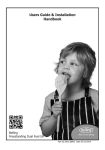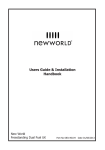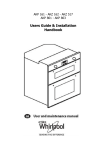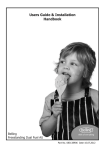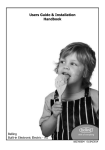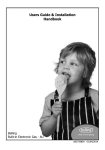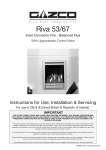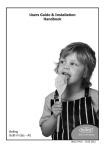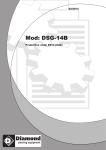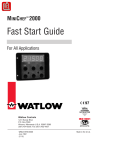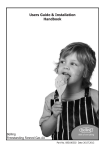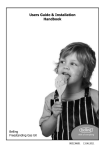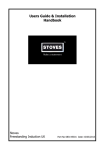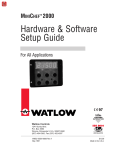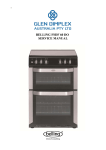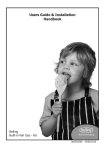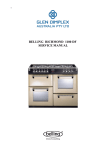Download User Manual
Transcript
Users Guide & Installation Handbook Belling Freestanding Dual Fuel AU Part No 083503000 Date 13/07/2015 CONTENTS & OUR WARRANTY CONTENTS your appliance’s model number and serial number. There is a space at the back of this book for recording that information. • INTRODUCTION • SAFETY • IGNITION PROCEDURE Important Notice • USING THE HOB, GRILL AND OVEN(S) • CLEANING • INSTALLATION INSTRUCTIONS • TECHNICAL DATA • WIRING DIAGRAM • CUSTOMER CARE Please note there may be a cooling fan fitted to this appliance. It is an integral part of its safety and functionality. When the appliance is installed, care must be taken that the cooling fan’s performance is not impeded by any objects coming into contact with it, e.g. installation pipes, leads, etc. Care must also be taken that there is sufficient air flow at the rear of the appliance for the cooling fan to run at its optimum efficiency. See clearance dimensions in the installation section of this booklet. During use, the appliance must never be disconnected from the mains supply as this will seriously affect the safety and performance of the appliance. Surfaces may become too hot and gas operated parts may not work efficiently. The cooling fan is designed to run on after control knobs have been turned off. This helps to keep the front of the appliance and the controls within safe temperature limits. INTRODUCTION Should you need it . . . . Inside the paperwork which has come with this appliance, there is a leaflet and card explaining the terms of our warranty and guarantee. Simply fill in the details on the card and post it off; this will register your appliance. Glen Dimplex Australia 1/21 Lionel Road Mount Waverley Victoria 3149 Australia Ph: 1300 556 816 Fx: 1800 058 900 Glen Dimplex New Zealand Pty 38 Harris Road, East Tamaki Auckland New Zealand Ph: 09 274 8265 Fx: 09 274 8472 If your appliance is covered by the warranty and guarantee, you will not be billed for work undertaken should your appliance be faulty. Terms and conditions do apply, so please read through the literature carefully. Please ensure that you have available ** THIS UNIT MUST BE INSTALLED BY A QUALIFIED TECHNICIAN ** Please retain your certificate of compliance. SAFETY BEFORE USING THE PRODUCT Make sure that you have removed all packaging and wrapping. Some of the items inside this appliance may have additional wrapping. It is advised that you turn the ovens and/ or grill on for a short while. This will burn off any residues left from manufacturing. There may be a smell which accompanies this process - but this is nothing to worry about and is harmless. It is recommended that you wash the oven shelves, baking tray, grill pan and grill pan trivet before their first use in hot soapy water. This will remove the protective oil coating. GENERAL WARNING! - The appliance and its accessible parts become hot during use. Care should be taken to avoid touching heating elements. Children less than 8 years of age shall be kept away unless continously supervised.This appliance can be used by children aged from 8 years and above and persons with reduced physical sensory or mental capabilities or lack of experience and knowledge if they have been given supervision or instruction concerning the use of the appliance in a safe way and understand the hazards involved. Children shall not play with the appliance. Cleaning and user maintenance shall not be made by children without supervision. WARNING! - If a range is placed on a base, measures must be taken to prevent the appliance slipping from the base. WARNING! - Oven and Range appliances must not be installed behind a decorative door in order to avoid overheating. WARNING! - Unattended cooking on a hob with fat or oil can be dangerous and may result in fire. NEVER try to extinguish a fire with water, but switch off the appliance and then cover the flame with a lid or damp cloth. WARNING! - Danger of fire: Do not store items on the cooking surfaces. WARNING! - Servicing should be carried out only by authorised personnel. WARNING! - The appliance must never be disconnected from the mains supply during use, as this will seriously affect the safety and performance, particularly in relation to surface temperatures becoming hot and gas operated parts not working efficiently. The cooling 5.406 SAFETY fan (if fitted) is designed to run on after the control knob has been switched off. WARNING! - Do not spray aerosols in the vicinity of this appliance while it is in operation. WARNING! - Do not store or use flammable liquids or items in the vicinity of this appliance. WARNING! - Do not modify this appliance. WARNING! - Do not use harsh abrasive cleaners or sharp metal scrapers to clean the oven door glass since they can scratch the surface, which may result in shattering of the glass. WARNING! - Do not operate the appliance without the glass panel correctly fitted. WARNING! - There is a risk of electric shock, so always make sure you have turned off and unplugged your appliance before starting. Always allow the product to cool down before you change a bulb. WARNING! - Accessible parts may become hot when the grill is in use. children should be kept away. WARNING! - Never place food, or dishes on the base of the main oven, the element is here and it will cause over heating. WARNING! - Do not modify the outer panels of this appliance in any way. WARNING! - This appliance must be earthed. WARNING! - The top element gets extremely hot when in use, so take care to avoid touching it. GAS WARNING! If you smell gas: Do not try to light any appliance. Do not touch any electrical switch. Contact your local gas supplier immediately. Caution: This appliance is for cooking purposes only. It must not be used for other purposes, for example room heating. Caution: The appliance must not be installed behind a decorative door in order to avoid overheating. Caution: The cooking process has to be supervised. A short term cooking process has to be supervised continuously. 5.406 SAFETY OVEN / GRILL Do • Always take care when removing food from the oven as the area around the cavity may be hot.Always use oven gloves when handling any utensils that have been in the oven as they will be hot. • Always make sure that the oven shelves are resting in the correct position between two runners. Do not place the oven shelves on top of the highest runner, as this is not stable and can lead to spillage or injury. • Always use the Minute Minder (if fitted) if you are leaving the oven unattended - this reduces the risk of food burning. Do Not • Never place items on the door while it is open. • Never wrap foil around the oven shelves or allow foil to block the flue. • Never drape tea towels near the oven while it is on; this will cause a fire hazard. • Never pull heavy items, such as turkeys or large joints of meat, out from the oven on the shelf, as they may overbalance and fall. • Never use this appliance to heat anything other than food items and do not use it for heating the room. GAS HOB Do • Always ensure that pan bases are dry and flat before using them on the hob. • Always position pans over the centre of the heat zone, and turn the handles to a safe position so they cannot be knocked or grabbed. • Always use pans which are no smaller than 100mm (4”), or larger than 250mm (10”). Use a 230 mm (9”) pan above the wok burner, if two or more other hotplate burners are in use at the same time. • Always match the size of pan to the heat zone – do not use large pans on small zones or vice versa. • Always make sure that the burner caps, rings and pansupports are correctly placed. This will prevent pans becoming unstable while in use and ensure an uninterrupted gas flow. Important Ensure the wok burner skirt is positioned with the feature shown in the diagram below facing the front of the cooker. Failure to do this will cause the gas to burn incorrectly with an irregular flame pattern. ENSURE WOK BURNER SKIRT IS POSITIONED WITH FEATURE FACING THE FRONT OF THE COOKER. Do Not • Never use double pans, rim-based pans, old or misshapen pans, or any pan that is not stable on a flat surface. • Never leave cooking fat, or oil, unattended. • Never use commercial simmering aids, or heat diffusers, as they create excessive heat and can damage the surface of the hob. • Never use the hob for any other purpose than cooking food. • Plastic cooking utensils can melt if they come into contact with a warm 5.406 SAFETY hob. Never leave them close to, or on top of the hob. If you have an electrical fire in the kitchen: • Never leave any heat zone alight without a pan covering it. This causes a fire hazard. • Pull the plug out, or switch off the power at the fuse box - this may be enough to stop the fire immediately • Never leave an empty pan on a heating zone. • • Never leave anything lying on the hob. Smother the fire with a fire blanket, or use a dry powder or carbon dioxide extinguisher • • Never heat a sealed tin of food, as it might explode. Remember: never use water on an electrical or cooking oil fire. • Never use the hob surface for storage. Fire Safety Advice Most kitchen fires occur when people are distracted or leave things unattended. Don’t let yourself be distracted while cooking. If you’re called away from the cooker, either take pans off the heat, or switch off your hob. If you do have a fire in the kitchen, don’t take any risks - get everyone out of your home and call the Fire Brigade. If a pan catches fire: • Do not move it - it is likely to be extremely hot. • Turn off the heat if it’s safe to do so - but never lean over a pan to reach the controls. • If you have a fire blanket, put it over the pan. If you have put the fire out, leave the pan to cool completely. Deep-fat frying presents more dangers in your kitchen. • Never fill a chip pan (or other deepfat fryer) more than one-third full of oil • Do not use a fire extinguisher on a pan of oil - the force of the extinguisher can spread the fire and create a fireball. 5.406 USING THE HOB - GAS • If your hob is supplied with left and right handed pan supports, ensure that they are located over the alignment pins and are sitting flat on the hob. • Use pans which are large enough to avoid overflows onto the hob surface. • Wipe any spillage as soon as possible. • Clean the hob top as regularly as possible, this will prevent any build up of grease which may be a fire hazard. • Pans should not be allowed to come into contact with coloured trims during use as this may cause discolouration of the surface • To simmer, turn the control knob to the small flame symbol. This will ensure that the flame is just large enough to gently heat the contents of the pan. • To use a round bottomed wok, position the wok stand provided onto the pan support above the wok burner, then position the wok onto the stand • To turn off, turn the control knob clockwise to the ‘off’ position. • Always make sure that your pans are placed centrally on the burners and do not allow the flame to extend over the base of the pan. • Avoid the use of pans that overhang the edges of the hotplate. Hob Ignition & Use • • • • • To turn on burners other than WOK, push in and turn the control knob to the full on position (large flame symbol). If your hob has an ignition switch on the facia, press it in until your burner lights. Hold the control knob in for 15 seconds then release. If the burner fails to light within this time, release the control knob and wait one minute before attempting to re-ignite. To turn on the WOK burner (if fitted), turn the WOK burner control knob to the simmer position (small flame symbol). Push in the control knob and after a couple of seconds press the ignition switch. Hold the control knob in for 15 seconds then release. If the burner fails to light within this time, release the control knob and wait one minute before attempting to re-ignite. NOTE : After the WOK burner is lit, please allow the burner to warm up for a few minutes before placing the pan over it. In the event of a power failure, or the ignition not working, then a lighted match or taper can be used to light the burner. Energy Saving • Position pans centrally over the elements. • Only heat the amount of liquid you need. • Once liquids have been brought to the boil, reduce the heat setting to a simmer. • Consider using a pressure cooker if possible. • Vegetables cut into small pieces will cook more quickly. 6.512 USING THE HOB - GAS • Use a pan which is a close match to your burner size. • Smaller burners are ideal for simmering and stewing in smaller pans, while the larger burners are ideal for frying and boiling. FOLD DOWN LID (IF FITTED) Caution: Glass lids may shatter when heated. Turn off all the burners before shutting the lid. When opening and closing the lid, use the cooler outer sides of the lid glass. The lid must be opened fully, so there is no danger of it closing while the hob is being used. Appliances fitted with glass lids are fitted with a safety system which will automatically turn off the hot plate burners if they are inadvertently left on as the lid is closed. If desired, the wok support should be located on top of the pan supports around the centre burner. The locating cutouts on the bottom of the wok support engage with the four fingers of the pan supports around the centre burner location. Ensure the wok support is located correctly, is fully engaged with the pan support fingers and is not able to rotate or slide across the pan supports before use. Always locate the wok support before lighting the burner. Caution: The wok support will become hot in use. Ensure it has cooled fully before removing or cleaning it. NOTE: Due to the temperatures the wok support will operate under during use, discolouration will occur. METAL LID (DUAL FUEL MODELS ONLY) If your Dual Fuel appliance is fitted with a Metal lid then this is NOT designed to cut off all hob burners when closed. Your hob burners are manufactured with flame supervision devices so in the event of this lid being closed accidentally the burners will be starved of oxygen thus cutting off the gas supply. The lid is not intended to be used as a work surface, as it becomes hot when any part of the cooker is in use, and the surface may be scratched if items with rough or sharp surfaces are placed on it. WOK SUPPORT (IF SUPPLIED) The wok support should only be used with a wok. No other style of pan is suitable for use with this accessory. 6.512 USING THE GRILL - ELECTRIC Caution: Accessible parts may be hot when the grill is used - young children should be kept away. A grill pan handle can be purchased as an optional extra from our spares department quoting the part numbers below: Handle - 082283705 Handle grip - 082469100 Contact details can be found on the customer care page. If cleaning the grill pan when it is hot, use oven gloves to move it. Food for grilling should be positioned centrally on the trivet. Using the grill Important: The grill door must be fully open when the grill is used. Open the grill door. Turn the control knob to the required setting. For best cooking results, we recommend that you preheat the dual grill for 3 minutes and the single grill for 5 minutes. For grilling small quantities of food, the centre (economy) grill can be used with the grill trivet inverted. For large quantities of food, the full grill can be used. Push the grill pan towards the back of the shelf, to position it under the grill. The speed of grilling can be controlled by adjusting the grill setting or by selecting a higher or lower shelf position. For toasting, and for grilling foods such as bacon, sausages or steaks, use a higher shelf position. For thicker foods such as chops or chicken joint pieces, use a middle to low shelf position. The grill trivet, inside the grill pan, can be inverted to give a high or low position, or it may be removed. To switch off, turn the control knob to the off position. Using aluminium foil Using aluminium foil to cover the grill pan, or putting items wrapped in foil under the grill creates a fire hazard. The cooling fan When the grill is switched on, the cooling fan comes on to keep the fascia and control knobs cool during grilling. The fan may continue to operate for a period after the grill has been switched off. During use the fan may cycle on and off, this is normal. Types of grill Variable rate grill: has adjustable heat settings 1 (low) to 8 (high) or 5 (high) - depending on the model. Single grill: has one grill element. The grill pan trivet MUST be inverted when using the single grill function. Dual grill: has two grill elements which can be used together, or as a single grill. Alternatively, you may have grill symbols similar to these below. or Full grill at 1/4 power Centre grill at full power Full grill area at full power 7.102 USING THE TOP OVEN - ELECTRIC (if fitted) When you are cooking keep children away from the vicinity of the oven. Caution: The top element gets extremely hot when in use, so take extra care to avoid touching it. The top oven is a conventional oven. Note: The top oven is not controlled by the programmer (if fitted). To turn on the top oven Turn the temperature control knob until the required temperature is selected. The red thermostat indicator will come on until the selected temperature is reached, and then go off; it will turn on and off periodically as the thermostat operates to maintain the selected temperature. To switch off, return the top oven control knob to the off position. Important: Never put items directly on the base of the oven, or cover the oven base with foil, as this may cause the element to overheat. Always position items on the shelf. The cooling fan When the top oven is switched on, you will hear the cooling fan come on - this keeps the fascia and control knobs of the appliance cool during cooking. The fan may continue to operate for a period after the oven control has been switched off. Preheat the oven until the indicator light switches off for the first time, this will take up to 15 minutes depending on the temperature selected. If you are not preheating the oven, the cooking times in the following guide may need to be extended, as they are based on a preheated oven. Shelf positions There are either 3 or 4 shelf positions, depending on which model you have purchased. These are counted from the bottom of the oven upwards, so shelf position 1 is the lowest. When cooking frozen or chilled food, use the highest possible shelf position, while allowing some clearance between the food and the top element. The oven shelf must be positioned with the up-stand at the rear of the oven and facing up. Position baking trays and roasting tins on the middle of the shelves, and leave one clear shelf position between shelves, to allow for circulation of heat. When using the top oven As part of the cooking process, hot air is expelled through a vent at the top of the oven(s). When opening the oven door, care should be taken to avoid any possible contact with potentially hot air, since this may cause discomfort to people with sensitive skin. We recommend that you hold the underneath of the oven door handle. Preheating The oven must be preheated when cooking frozen or chilled foods, and we recommend preheating for yeast mixtures, batters, soufflés, and whisked sponges. 8.100 USING THE TOP OVEN - ELECTRIC (if fitted) TOP OVEN BAKING GUIDE Cooking temperatures Cooking times The temperature settings and time given in the Baking Guides are based on dishes made with block margarine. If soft tub margarine is used, it may be necessary to reduce the temperature setting. If a recipe gives a different temperature setting to that shown in the guide, the recipe instruction should be followed. These times are based on cooking in a preheated oven. These cooking times are approximate, because the size and type of cooking dish will influence time as personal preferences. Because the top oven is more compact, it may be necessary to reduce cooking temperatures specified in recipes by up to 20°C. Shelf positions As a general guide, when cooking frozen or chilled food, use the highest possible shelf position, while allowing some clearance between the food and the top element. Follow the instructions given on packaging. Item Use the baking guide as a reference for determining which temperatures to use. Temperature Shelf Approximate cooking time (°C) Position Small cakes Victoria sandwich (2 x 180mm / 7”) Swiss roll Semi rich fruit cake (180mm x 7”) Scones Meringues 180 160 1 1 15 - 20 mins 20 - 25 mins 200 140 1 1 8 - 12 mins 2¼ - 2¾ hours 215 90 - 100 1 1 10 - 15 mins 2 - 3 hours Shortcrust pastry Puff / flaky pastry Choux pasrty 200 - 210 200 - 210 200 - 210 1 1 1 Depends on size & type of cooking dish & also the filling Biscuits Sponge pudding Milk pudding 160 - 200 150 140 2 1 1 10 - 20 mins 30 - 45 mins 2 - 2½ hours 8.100 USING THE MAIN OVEN - ELECTRIC Accessible parts may be hot when the oven is used. Young children should be kept away. To switch on the oven Turn the oven control knob(s) to the required setting. The red thermostat neon (if fitted) will come on until the selected temperature is reached and then go off; it will turn on and off periodically as the thermostat operates to maintain the selected temperature. Manual Operation (fanned only) The programmer must be set to manual operation before the main oven can be used. If A (Auto) is on the programmer display, return the oven to manual by pressing the up and down buttons simultaneously Any programme which has been set is cancelled. The cooling fan The cooling fan may operate when the main oven is on and may continue to operate for a period after the oven has been switched off. To switch off, return the control knob to the off position. OVEN FURNITURE When using the oven The oven shelf must be positioned with the upstand at the rear of the oven and facing upwards. As part of the cooking process, hot air is expelled through a vent in the oven. When opening the oven door, care should be taken to avoid any possible contact with potentially hot air, since this may cause discomfort to people with sensitive skin. We recommend that you hold the underneath of the oven door handle. Oven shelves Position baking trays and roasting tins on the middle of the shelves. Baking tray and roasting tins For best cooked results and even browning, the recommended size baking trays and roasting tins that should be used are as follows; PREHEATING Baking tray 350mm x 250mm Fanned oven This size of baking tray will hold up to 12 small cakes. When cooking sensitive items such as souffle and Yorkshire puddings or, when cooking bread, we recommend that the oven is preheated until the neon switches off for the first time. For any other types of cooking, a preheat may not be required. Roasting tin 370mm x 320mm We recommend that you use good quality cookware. Poor quality trays and tins may warp when heated, leading to uneven baking results. Conventional oven Preheating is always required 9.100 USING THE MAIN OVEN - ELECTRIC Slow cooking ( Setting or 100°C) • Make sure that frozen foods are thoroughly thawed before cooking. • Do not slow cook joints of meat or poultry weighing more than 2¼kg/4½lb. • Preheat the oven to 170°C and cook for 30 minutes, then adjust the oven control to or 100°C (slow cook setting) for the remainder of the cooking time. • Slow cooking times will be about 3 times as long as conventional cooking times. • Do not open the oven door unnecessarily during slow cooking, as this will result in heat loss at low temperatures. • Always use dishes with tightly fitting lids. To rectify badly fitting lids, place foil over the dish underneath the lid. Aluminium foil Use foil only to cover food or cooking dishes, using foil to cover the shelves or oven base creates a fire hazard. Cooking with a fanned oven As this is a high efficiency oven, you may notice the emission of steam from the oven when the door is opened. Please take care when opening the door. If you are used to cooking with a conventional oven you will find a number of differences to cooking with a fan oven which will require a different approach: There are no zones of heat in a fan oven as the convection fan at the back of the oven ensures an even temperature throughout the oven. This makes it ideal for batch baking - eg; when planning a party as all the items will be cooked within the same length of time. Foods are cooked at a lower temperature than a conventional oven, so conventional recipe temperature may have to be reduced. Please refer to the conversion chart. Preheating is generally not necessary as a fan oven warms up quickly. There is no flavour transference in a fan oven, which means you can cook strong smelling foods such as fish at the same time as mild foods - eg; milk puddings. When batch baking foods that will rise during cooking - eg; bread - always ensure that enough space has been left between the shelves to allow for the rise. Notes: When 2 or more shelves are being used, it may be necessary to increase the cooking time slightly. Because the 2 oven shelves are wider than in many ovens, it is possible to cook 2 items per shelf - eg; 2 victoria sandwiches or 2 casseroles. Although you need to keep in mind the points ‘To help the air circulate freely’ with careful choice of dishes and tins, it is possible to cook a complete meal, and perhaps something else for the freezer, in the oven at the same time. When roasting meats, you will notice that fat splashing is reduced, which is due in part to the lower oven temperatures, and will help keep cleaning of the oven to a minimum. Because a fan oven has an even temperature throughout the oven, there is no need to follow the shelf positions given in the baking guide. 9.100 USING THE MAIN OVEN - ELECTRIC There is no need to interchange dishes onto different shelves part way through cooking, as with a conventional oven. To help the air circulate freely Position the shelves evenly within the oven and maintain a clearance from the oven roof and base. If more than one cooking dish or baking tray is to be used on a shelf, leave a gap of at least 25mm between the items themselves and the oven interior. Defrosting and cooling in the main oven To defrost frozen foods, turn the main oven control to the defrost position, place the food in the centre of the oven and close the door. To cool foods after cooking prior to refrigerating or freezing, turn the main oven control to the defrost position and open the door. Defrosting times Small or thin pieces of frozen fish or meat - eg; fish filets, prawns & mince will take approximately 1 - 2 hours. Be safe Do not defrost stuffed poultry using this method. Do not defrost larger joints of meat and poultry over 2kg/4lb using this method. Never place uncooked food for defrosting next to cooked food which is to be cooled, as this can lead to cross contamination. Defrosting meat, poultry, and fish can be accelerated using this method but make sure they are completely thawed before cooking thoroughly. Place meat and poultry on a trivet in a meat tin. MAIN OVEN BAKING GUIDE Cooking times & temperatures The temperature settings and times given in the baking guide are based on dishes made with block margarine. If soft tub margarine is used it may be necessary to reduce the temperature setting. Allow enough space between shelves for food that will rise during cooking. Do not place items on the oven base as this will prevent air circulating freely. Placing the food in a single layer will reduce the thawing time. A medium sized casserole or stew will take approximately 3 - 4 hours. A 1½kg/3lb oven ready chicken will take approximately 5 hours, remove the giblets as soon as possible. 9.100 USING THE MAIN OVEN - ELECTRIC Note: This is a fanned oven, therefore some adjustment will have to be made to conventional cooking temperatures. The table below shows conventional cooking temperatures, fanned oven temperatures and gas marks. For optimum results, conventional temperatures need to be converted to fanned oven temperatures. For example, an item which would normally cook at a conventional temperature of 180 °C, will now cook at the fanned oven temperature of 160°C. Conventional temperature Fanned Oven (°C) (°C) 100 110 130 140 150 160 180-190 200 220 230 250 100 110 120 130 140 150 160 170 180 190 200 Food Type Cakes Temperature settings (°C) Conv Gas Mark 1/4 1/4 1/2 1 2 3 4-5 6 7 8 9 Time Approx. Shelf Position Fanned Small cakes Victoria sandwich Semi rich fruit cake Christmas cake 190 180 150 150 160 160 125 125 15 - 25 20 - 30 2.5HRS - 3HRS 2.5HRS - 3HRS 2-4 3 2 2 Puddings Bread and butter pudding Fruit crumble 170 200 150 175 45 - 1hr 40 - 1hr 3 3 Miscellaneous Yorkshire pudding: large small Shortcrust pastry 220 220 200 200 200 180 40 - 48 15 - 20 Depends on filling 4-5 4-5 4-5 9.100 USING THE MAIN OVEN - ELECTRIC Traditional fruit cakes Roast turkey It should be remembered that ovens can vary over time, therefore cooking times can vary, making it difficult to be precise when baking fruit cakes. Roasting turkey involves cooking two different types of meat - the delicate light breast meat, which must not be allowed to dry out, and the darker leg meat, which takes longer to cook. It is necessary therefore, to test the cake before removal from the oven. Use a fine warmed skewer inserted into the centre of the cake. If the skewer comes out clean, then the cake is cooked. The turkey must be roasted long enough for the legs to cook, so frequent basting is necessary. The breast meat can be covered once browned. • Follow the temperatures suggested in the recipe and then adjust accordingly to the conversion table. • Always make sure that the turkey is completely thawed and that the giblets are removed before cooking. • Do not attempt to make Christmas cakes larger than the oven can cope with, you should allow at least 25mm (1”) space between the oven walls and the tin. • Turkey should be roasted at 160°C - 180°C (fanned) or 180°C - 200°C (conventional) for 20 minutes per 450g (1 lb), plus 20 minutes, unless packaging advises otherwise. • Always follow the temperatures recommended in the recipe. • • To protect a very rich fruit cake during cooking, tie 2 layers of brown paper around the tin. The turkey can be open roasted, breast side down, for half of the cook time, and then turned over for the remainder of the cooking time. • If the turkey is stuffed, add 5 minutes per 450g (1 lb) to the cooking time. • If roasting turkey covered with foil, add 5 minutes per 450g (1 lb) to the cooking time. • We recommend that the cake tin is not stood on layers of brown paper, as this can hinder effective circulation of air. • Do not use soft tub margarine for rich fruit cakes, unless specified in the recipe. • Always use the correct size and shape of tin for the recipe quantities. To test if the turkey is cooked, push a fine skewer into the thickest part of the thigh. If the juices run clear, the turkey is cooked. If the juices are still pink, the turkey will need longer cooking. 9.100 USING THE MAIN OVEN - ELECTRIC Roasting guide Notes: The times given in the roasting guide are only approximate, because the size and age of the bird will influence cooking times as will the shape of a joint and the proportion of the bone. • When cooking stuffed meat or poultry calculate the cooking time from the total weight of the meat plus the stuffing. • For joints cooked in foil or covered roasters, and for lidded casseroles, add 5 minutes per 450g (1lb) to the calculated cooking time. • Smaller joints weighing less than 1.25kg (2½lb) may require 5 minutes per 450g (1lb) extra cooking time. • Position the oven shelf so that the meat or poultry is in the centre of the oven. • It is recommended that the appliance is cleaned after open roasting. Frozen meat should be thoroughly thawed before cooking. For large joints it is advisable to thaw over night. Frozen poultry should be thoroughly thawed before cooking. The time required depends on the size of the bird - eg; a large turkey may take up to 48 hours to thaw. Use of a trivet with a roasting tin will reduce fat splashing and will help to keep the oven interior clean. Alternatively, to help reduce fat splashing, potatoes or other vegetables can be roasted around the meat/poultry. Cook in main oven at: Approximate Cooking Time 160°C - 180°C (fanned) (preheated oven) 180°C - 200°C (conventional) Beef Rare Medium Well done 20 minutes per 450g (1lb), plus 20 minutes 25 minutes per 450g (1lb), plus 25 minutes 30 minutes per 450g (1lb), plus 30 minutes Lamb Medium Well Done 25 minutes per 450g (1lb), plus 25 minutes 30 minutes per 450g (1lb), plus 30 minutes Pork 35 minutes per 450g (1lb), plus 35 minutes Poultry 20 minutes per 450g (1lb), plus 20 minutes 9.100 USING THE CLOCK/PROGRAMMER-ELEC(if fitted) THE ALTERNATIVE PROGRAMMERS There are two types of programmer covered in this section - push button & touch control. Both programmers have the same symbol variants & functions but may vary in their method of operation. The push button programmer Symbol Symbol - Symbols on the LED display. Down/minus This ‘A’ symbol appears when either a semi, or fully automatic program is selected. This symbol will flash while a program is being set. Used to decrease cook / end time, remove minutes from the minute minder and adjust the time of day. Also for listening to and setting the alarm tone. Once a program is set the symbol will light up, and remain lit until the alarm sounds, or the program is cancelled. What is it? Up/plus + Used to increase cook / end time, add minutes to the minute minder and adjust the time of day. Function button Used to select the FUNC- MODE functions available on this timer. TION or Press once for: Minute Minder. Press twice for: Cook time Press three times for: End time. How to use these functions is explained later on in this section. This bell symbol appears when the Minute Minder function has been selected. While the Minute Minder is being set, the Bell symbol flashes. Once the length of time is set, the Bell symbol remains lit until the time runs down, or the function is cancelled. This message and ‘A’ symbol appear when you are asked to set the length of time you require the oven to cook automatically for.Using the Up and Down buttons adjusts this accordingly. The ‘function’ button in the centre is used for setting the minute minder and setting up the automatic cooking. See below for details. 11.100 USING THE CLOCK/PROGRAMMER-ELEC(if fitted) This message and ‘A’ symbol appear when you are asked to enter in an end time, or when you would like the oven to switch itself off. Setting the minute minder To set the time of day • Press the Up and Down buttons together for a few seconds, and release. • The ‘•’ in between the numbers on the LED Display will begin to flash. • While the ‘•’ is flashing it is possible to adjust the time using the Up and Down buttons. Once the time has been set, allow approximately 30 seconds before using any of the other timer functions. This ensures that the time will remain correct. To select an alarm tone • To set the Minute Minder, press the Function button once. The bell symbol will appear and start flashing. The flashing only lasts for 5 seconds so the time must be set within this time frame. • Use the Up and Down button to set the length of time required. Once this has been done, the Minute Minder is set. • When the desired length of time has counted down the alarm will sound. • To cancel the tone, press any of the buttons. • To cancel the Minute Minder at any time, press the Up and Down buttons together. There are three tones to choose from. • Press and hold the down button to listen to the first tone. • Release the down button and press it again to listen to the second tone etc. • Releasing the down button after the tone has sounded will automatically select that tone. 11.100 USING THE CLOCK/PROGRAMMER-ELEC(if fitted) Semi-automatic cooking There are two types of semi automatic cooking available on this appliance. The oven must be switched on, and in use to use either of these functions successfully. The Duration method allows you to set the oven for a specific length of time. If a dish needed 2 hours to cook, then it would be possible for you to set the oven to turn off 2 hours later. This allows you to be sure that your food will be cooked for a set length of time and no longer. The End Time method allows you to enter a specific time when you would like the oven to switch off. If you wish to leave the oven unattended, then it offers peace of mind that the oven will have turned itself off at the set time. However, once the program is set then it cannot be adjusted. Extra time cannot be added, nor can the end time be extended. For the instructions on how to use both of these functions, please see the following page. Fully automatic cooking This function incorporates both a duration and an end time and is meant to be used when you wish to delay the start time. We recommend that the first few times this function is used you are in the house, this will familiarise you with your oven and prevents food from being over cooked or under cooked. Care must be taken when selecting foods for this function, it is not recommended for certain food items which may spoil, or are sensitive to being left. It is also advisable to set the end time to be as close to your return as possible to prevent food being left standing. To cancel the semi automatic programs, press both the Up and Down buttons together. This can be done at any time during the cooking process. Then if necessary, re program. 11.100 USING THE CLOCK/PROGRAMMER-ELEC(if fitted) SEMI-AUTOMATIC COOKING The duration method • Press the Function button twice,(1) which will skip past the Minute Minder. • The LED display will flash the word ‘dur’, (2) and the ‘A’ will flash on the left hand side of the display. • Use the Up and Down buttons to set the length of time you want to cook for.(3) This must be done within 5 seconds or the time of day will show again. Once this is done the oven will automatically switch off once the time has elapsed, and the alarm will sound. To switch off the alarm, press any button. To view any remaining time press the function button twice. The end time method • Press the Function button three times, which will skip past the Minute Minder and the Duration programmer. (4) • The LED display will flash the word ‘End’ and the ‘A’ will flash on the left hand side of the display. (5) • Use the Up and Down buttons to select the time the oven is required to turn off. (6) Once this is done the oven will turn itself off at the time you have selected. To switch off the alarm, press any button. 11.100 USING THE CLOCK/PROGRAMMER-ELEC(if fitted) FULLY AUTOMATIC COOKING (EXAMPLE) This programming method is best suited for when a delayed start time is required. Unlike the semi automatic methods this requires both the duration and the end time to be entered. The timer will work out the start time and begin cooking. • Press the function button twice to select the length of time your food will need. (7) • The ‘A’ on the left hand side will flash and the ‘dur’ message will flash up. (8) • Using the Up and Down buttons set the time you require within 5 seconds of the ‘dur’ message. (9) • Press the function button three times until the ‘A’ flashes again and the ‘End’ messages appears. (10) & (11) • Using the Up and Down buttons, set the time you would like the oven to switch off. (12) • Set the temperature of the oven and place the food inside. While the automatic function is running, the ‘A’ will appear statically on the display, with the time. Try to keep the end time as close to when you expect to return, this will prevent cooked food from being left standing in a warm oven. The timer will calculate the appropriate start time. To switch off the alarm, press any button. 11.100 USING THE CLOCK/PROGRAMMER-ELEC(if fitted) The touch control programmer There are three touch control icons for this timer - the table below shows you what the symbols look like, depending on the model type, & their functions. The ‘function’ icon in the centre is used for setting the minute minder & setting up the automatic cooking - see below for details. Note - some functions require you to ‘touch & hold’ an icon for a few seconds, whilst others require you to just ‘touch’ the icon without holding. Symbol Symbol What is it? - Used to decrease cook / end time, remove minutes from the minute minder and adjust the time of day. Also for listening to and setting the alarm tone. Down/minus Up/plus + Used to increase cook / end time, add minutes to the minute minder and adjust the time of day. Function icon Used to select the functions available FUNC- MODE on this timer. TION Touch once for: Minute Minder. Symbols on the LED display. This ‘A’ symbol appears when either a semi, or fully automatic program is selected. This symbol will flash while a program is being set. Once a program is set the symbol will light up, and remain lit until the alarm sounds, or the program is cancelled. This Bell symbol appears when the Minute Minder function has been selected. While the Minute Minder is being set, the Bell symbol flashes. Once the length of time is set, the Bell symbol remains lit until the time runs down, or the function is cancelled. This message and ‘A’ symbol appear when you are asked to set the length of time you require the oven to cook automatically for. Using the Up and Down icons adjusts this accordingly. This message and ‘A’ symbol appear when you are asked to enter in an end time, or when you would like the oven to switch itself off. Touch twice for: Cook time Touch three times for: End time. How to use these functions is explained later on in this section. 11.100 USING THE CLOCK/PROGRAMMER-ELEC(if fitted) Setting the time of day Semi-automatic cooking Touch & hold the centre (function) icon for a few seconds until the ● symbol between the numbers on the LED display flashes. Method 1 - duration (switch off after set time period): While the ● symbol is flashing, you can adjust the time of day by touching the plus & minus icons. Please note: the hours & minutes adjust quickly. Important - once the time of day has been set, allow approximately 30 seconds before using any of the other programmer functions. This ensures that the time of day will remain correct. Setting an alarm tone Touch & hold the plus & minus icons simultaneously until the ● symbol flashes & you hear a beep - then touch the centre (function) icon. Touch the minus icon to select the tone. You can change the tone by repeatedly touching the minus icon - there are three tones to choose from. Setting the minute minder To set the minute minder, touch & hold the centre (function) icon until the bell symbol appears & begins to flash. Important - the flashing will last for approximately five seconds, so any setting must be carried out within this time frame. Touch the plus & minus icons to set the length of time required. Once this has been done, the minute minder is set. When the desired length of time has counted down, the alarm will sound. To cancel the tone, touch & hold any of the icons. Touch & hold the centre (function) icon; the bell will flash & you will hear a beep. Touch the centre (function) icon again - this will skip past the minute minder function. The display will flash the word ‘dur’ & the ‘A’ will flash on the left hand of the display. Use the plus & minus icons to set the length of time you want to cook for. The flashing will last for approximately five seconds, so the setting must be done within this time frame or the time of day will show again. Once the duration has been set, the oven will automatically switch off. When the set time has elapsed the alarm will sound. To switch the alarm off, touch any icon. To view any remaining time, touch & hold the centre (function) icon & touch again. To cancel the semi-automatic programme at any time, touch the plus & minus icons together. Method 2 - end time (switch off at a set end time): Touch & hold the centre (function) icon; the bell will flash & you will hear a beep. Touch the centre (function) icon again - twice - this will skip past the minute minder & duration functions. The display will flash the word ‘End’ & the ‘A’ will flash on the left hand of the display. To cancel the minute minder at any time, touch & hold the plus & minus icons together. 11.100 USING THE CLOCK/PROGRAMMER-ELEC(if fitted) Use the plus & minus icons to select the time the oven is required to switch off. Once this is done the oven will switch itself off at the pre-selected time. To turn the alarm off, touch any icon. To cancel the automatic programme at any time, touch the plus & minus icons together. To cancel the semi-automatic programme at any time, touch the plus & minus icons together. Fully automatic cooking This function allows the cooker to switch on & off automatically. It requires both the duration & the end time to be entered. The timer will work out the start time & begin cooking. Touch & hold the centre (function) icon; the bell will flash & you will hear a beep. Touch the centre (function) icon again - this will skip past the minute minder function. The display will flash the word ‘dur’ & the ‘A’ will flash on the left hand of the display. Use the plus & minus icons to set the length of time you want to cook for. The flashing will last for approximately five seconds, so the setting must be done within this time frame or the time of day will show again. Touch the centre (function) icon again this skips past the minute minder & duration functions. The display will flash the word ‘End’ & the ‘A’ will flash on the left hand of the display. Use the plus & minus icons to select the time the oven is required to switch off. Set the temperature of the oven & place the food inside. The timer will calculate the start time. When this is done the oven will turn itself off at the time you have selected. To switch off the alarm, touch any icon. 11.100 CLEANING General • It is important to clean the product regularly as a build up of fat can affect its performance or damage it and may invalidate your guarantee. • Always switch off your appliance and allow it to cool down before you clean any part of it. • Do not use undiluted bleaches, products containing chlorides, wire wool or abrasive cleaners on aluminium, stainless steel, or plastic/ painted parts as they can damage the appliance. Nylon pads can also be unsuitable. • Take extra care when cleaning over symbols on fascia panels. Excessive cleaning can lead to the symbols fading. • If your product is fitted with stainless steel cladding strips. You may notice a small white residue on the outer edges, this can be removed with a non abrasive wipe. • Some foods are corrosive eg; vinegar, fruit juices and especially salt - they can mark or damage the metal or paint work, if they are left on the surface. • Only use a clean cloth wrung out in hot soapy water, and dry with a soft cloth. as they can contain salts, which will damage the metal. Enamel surfaces & parts • If larger splashes of fat do not readily disappear, you can use a mild cream cleaner to remove them. Glass parts WARNING:- Do not use harsh abrasive cleaners or sharp metal scrapers to clean the oven door glass since they can scratch the surface, which may result in shattering of the glass. Chrome plated parts • Use a moist soap filled pad, or place in a dishwasher Stainless steel & Aluminium surfaces • Stubborn marks can be removed using a stainless steel cleaner. Supplies can be purchased from the Customer Care Centre. • Sharp objects can mark the surface of stainless steel, but will become less noticeable with time. • Baby oil can be used to restore stainless steel finishes - but only use a few drops. Don’t use cooking oils 12.000 CLEANING REMOVING OVEN PARTS FOR CLEANING Inner Door Glass (glass doors only) • Some models have a removable, inner door glass. It can be removed for cleaning but it must be replaced the right way up. If there is any writing on the glass, you must be able to read it clearly when the cavity doors are open. • Always make sure that the glass is pushed fully into the Stop position. • To remove the glass panel, open the door wide, hold the top and bottom edges and slide out. • Warning: Do not operate the appliance without the glass panel correctly fitted. • For your safety, glass door panels are made of toughened glass. This ensures that, in the unlikely event that a panel breaks, it does so into small fragments to minimise the risk of injury. Please take care when handling, using or cleaning all glass panels, as any damage to the surfaces or edges may result in the glass breaking without warning or apparent cause at a later date. Should any glass panel be damaged, we strongly recommend that it is replaced immediately. Shelf Runners • Shelf runners can be removed to enable you to clean them thoroughly. Make sure they are cool to touch and then grasp the runners and slide out of their hanging holes. Pull out to clean 12.100 CLEANING GAS HOB Cast iron griddle or pan supports (if fitted) Burner caps and heads • The slots in the burner head where the flames burn should be cleared of deposits. • Clean with a nylon brush, rinse and then dry thoroughly. There may be brown coloured markings on your burners; these are carbon deposits or fat stains and can be removed using a soap filled pad. • Do not put burners in the dishwasher or soak them. Using dishwasher powders, washing up liquids and caustic pastes can damage the burners. • Burner caps and heads must be repositioned correctly so that they sit squarely on to the hob as shown. This is particularly important with stainless steel models as failure to reposition the caps correctly may result in discolouration of the stainless steel around the burners. burner cap • Ensure the griddle has fully cooled and scrape off any stubborn marks and bits of food with a plastic or wooden cooking implement. Rinse in warm soapy water and dry with a tea towel. • Do not clean in a dishwasher. • If you notice any rusting on your griddle, or pan-supports, simply clean in warm soapy water, then re-season. • To season: Heat the griddle for 30 seconds at a medium setting then switch off. Use a minimum amount of unsalted vegetable oil, on a dry cloth or paper towel, and apply a thin coat of oil to the element surface. Wipe off the excess and re-heat the griddle for one minute. correct parallel burner head incorrect angled burner cap not central incorrect 12.200 INSTALLATION - DUAL FUEL Before you start: Please read the instructions. Planning your installation will save you time and effort. Prior to installation, ensure that the local distribution conditions (nature of the gas and gas pressure) and the adjustment of the appliance are compatible. The adjustment conditions are stated on the data badge. This appliance is not connected to a combustion evacuation device. It shall be installed and connected in accordance with current installation regulation. Particular attention shall be given to the relevant requirements regarding ventilation. The information below is crucial to installing this appliance correctly and safely. Gas Safety (Installation & Use) Regulations This appliance must by an authorised person in accordance with the Australian Gas Installation Standard AS5601 the manufacturers installation instructions, local gas fitting regulations, and any other relevant statutory regulations. Particular attention should be given to relevant requirements regarding ventilation. Failure to install appliances correctly is dangerous and could lead to prosecution. Ventilation Requirements Ventilation must be as specified by AS 5601 Installation code. The room containing the appliance should have an air supply. An appliance should be installed in a location for complete combustion of gas, proper flueing and to maintain ambient temperature of the immediate surrounding at safe limits, under normal conditions. Failure to install appliances correctly is dangerous and could lead to prosecution. If the appliance is placed on a base, measures have to be taken to prevent it slipping from the base. Caution - The use of gas cooking appliance results in the production of heat, moisture and products of combustion in the room in which it was installed. Ensure that the kitchen is well ventilated especially when the appliance is in use: keep natural ventilation holes open or install a mechanical ventilation device (mechanical extractor hood). INSTALLATION - DUAL FUEL Windows and permanent vents should therefore not be blocked or removed without first consulting a GAS SAFE gas installer. Failure to install appliances correctly is dangerous and could lead to prosecution. Whilst every care is taken to eliminate burrs and raw edges from this product, please take care when handling - we recommend the use of protective gloves during installation. Moving the cooker Please note that the weight of this appliance is approximately 60kg (unpacked). Take care if the appli ance needs to be lifted during installation - always use an appropriate method of lifting. Do not attempt to move the cooker by pulling on the doors or handles. Open the door and grasp the frame of the cooker, taking care that the door does not shut on your fingers. Take care to avoid damage to soft or uneven floor coverings when moving the appliance. Some cushioned vinyl floor coverings may not be designed to withstand sliding appliances without marking or damage. CLEARANCES & DIMENSIONS Appliance dimensions All sizes are nominal - some variation is to be expected. The ‘depth’ of the cooker, as given below, is to the front of the door & excluding knobs & handles. depth: width: height height - 600mm 500/549/600mm lid down:900 - 915mm lid raised:1430 - 1445mm Clearances No shelfor overhang or cooker hood should be closer than a minimum of 650mm, but check with cooker hood manufacturer’s recommendations. The cooker must have a side clearance above hob level of 90mm up to a height of 400mm. Cookers with drop-down main oven doors may be fitted flush to base units. However, for models with side opening doors, we recommend a side clearance of 30mm between the cooker and any side wall adjacent to the hinged side of the doors. 90 mm 90 mm 650 mm 400 mm 400 mm INSTALLATION - DUAL FUEL Levelling Your Cooker Place a spirit level on a baking sheet onto an oven shelf. The cooker is fitted with LEVELLING FEET (1). Level your cooker to your desired height using the levelling feet at the front and rear of the cooker. A minimum clearance of 15mm is essential for clean air supply. Place the cooker in position and draw a PENCIL LINE level with the front edge (2). Mark the centre of the cooker to give a CENTRE LINE (3). Remove the cooker and mark off 200mm to the right of the centre line (4) on the rear wall. Measure from FLOOR LEVEL to the ENGAGEMENT EDGE where the stability bracket will rest and add 2mm (5). Transfer this dimension to the rear wall and secure the bracket to the wall at this height (6) using the two off centre holes in the single bracket. Stability bracket The stability bracket provided must be fitted to the back of the cooker and fitted as follows: INSTALLATION - DUAL FUEL CONNECT TO THE ELECTRICITY SUPPLY - DUAL FUEL The appliance must be installed by a competent electrician using a double pole control unit of 32 ampere minimum capacity with 3mm minimum contact separation at all poles. We recommend that the appliance is connected by a qualified electrician who is a member of the N.I.C.E.I.C. and who will comply with the I.E.E. and local regulation. 1. Access to the mains terminal is gained by opening the terminal block cover at the rear of the appliance (use a small flatbladed screwdriver). 2. Connection should be made with 6.0mm2 flexible twin and earth cable. 3. First strip the wires, then push the cable through the cable clamp in the terminal block cover. 4. Connect the cable to the terminal block and tighten the cable clamp screw (see diagram). 5. Close the terminal box, ensuring that the cover is engaged on the locking tabs. Your appliance will be fitted with one of the two terminal blocks below, Block A Block B INSTALLATION - DUAL FUEL PRODUCTS WITH CAST IRON LID (WHERE FITTED) A 55mm clearance is required from the back of the hotplate to the rear wall, to allow the lid to be opened fully. To ensure this clearance is maintained, the infill piece (supplied) should be fitted using the instructions below. Fitting the infill piece between the rear of the hob and the wall Fix the infill piece to the wall - using suitable screws and wall fixings (not supplied) - and ensure it is level with the hotplate as shown. Note: The 55mm clearance dimension should not be reduced. Connection to the gas supply should be made using the Aquaknect AS/NZS 1869 class B hose assembly with an internal diameter of not less than 10mm and regulator (regulator for use with natural gas) For operation on NG The appliance regulator provided must be oriented so that the pressure nipple (on the outlet) is accessible. The governor must be fitted to the supply line. For operation on ULPG (propane) The pressure test point fitting provided must be fitted to the supply line. NOTE: The temperature rise of the areas at the rear of the cooker that are likely to come into contact with the flexible hose do not exceed 70˙C. The inlet to the cooker is ½” BSP internal situated at the rear right corner. Fit the bayonet connection. This should be located so as to ensure that the flexible connector hose does not kink. 550mm 55mm CONNECT TO THE GAS SUPPLY Means of isolation shall be provided at the shut off point by either an approved quick connect device or a Type 1 manual shut off valve. The outlet of the quick connect device shall be at, or below, the horizontal position. Under no circumstances should the flexible connector be allowed to come into contact with the vertical oven flue tubes on the rear of the appliance. Use a 900mm - 1200mm length of flexible connector. Ensure that all pipework is of the correct rating for both size and temperature. Natural Gas- Installations must conform to local codes or, in the absence of local codes, with AS:5601 as well as the requirements of any local council, gas, electricity authority or other statutory regulation. INSTALLATION - DUAL FUEL After installation, make sure all connections are gas sound. Checking the gas supply Check the manometer zero point is correct. Connect the manometer to the cooker pressure test point. Turn on the gas supply and the electricity then try to ignite the gas. Note: It will take additional time to light the gas for the first time as air needs to be purged from the pipes. Check the operating pressure for the particular gas types. NG 1.00 kPa, ULPG 2.75 kPa For ULPG cookers Adjust the regulator if necessary (this may be remote from the cooker). For NG cookers Regulators are supplied pre-adjusted and configured by the component maker for use with Natural Gas. The appliance installer should not be required to make an adjustment to obtain the correct outlet pressure setting. Regulator outlet pressure should be checked when a) All burners are operating simultaneously at the full on setting. b) When the smallest burner of the appliance is operating at the low setting. Under these conditions the outlet pressure should be between 0.8 kPa and 1.2 kPa. COMMISSIONING Burner aeration All burners have fixed aeration and no adjustment is possible. Check the operation of electrical components, viz; Clock programmer/ Minute minder Check functions as described earlier in this booklet. Oven light & convection fan Open the main oven door. Turn the main oven control knob to the defrost setting , check the oven light and convection fan both come on. Turn control knob back to off position. Cooling fan Open the grill door. Turn the grill control knob to the full power setting . Check that the cooling fan operates. Turn control knob back to off position and check cooling fan switches off immediately. Lid safety system Ignite all hotplate burners including wok. Attempt to close the lid and make sure all flames are extinguished by the safety system. If you are satisfied that the cooker is operating correctly, turn it off and show the customer how to use it. Make sure you ask the customer to operate the clock (if fitted) and controls. Explain to the user that the lid safety system must not be used as a means of turning off the hotplate burners. Control knobs must always be turned to the off position after use. Note- If the cooker does not perform correctly, inform the customer of the problem and put a warning notice on the cooker. If the problem is dangerous, then disconnect the cooker. If there is a fault, then the customer should be advised to contact the manufacturer’s local service organisation or the retailer. Before leaving the installation hand over the handbook to the customer. Thank you. TECHNICAL DATA TYPE OF GAS: Injectors Used Please see data badge for your specified gas type. Never attempt to convert an appliance - unless the data badge states that you can. This product can be converted from NG to ULPG using the kit provided (Part No. 013513000). Burner Aeration:Fixed Natural Gas ULPG Small 82 50 Medium 118 70 Wok 185 104 (Note: Injector references: Refer to injector orifice size in 0.01mm increments) Pressure setting: Natural Gas - 1.0 kPa Propane - 2.75 kPa Electrical supply: 240V ~ 50Hz 4865W Countries of destination: AU NZ Data - Oven and Grill Products FSDF60DO AU / FSDF61DOWS/S AU / BR54DF AU Fuel Type Hotplate Burner /Element Nominal Rate Qn Natural Gas Hob - small Hob - medium x 2 Hob - Wok 3.45MJ/h 6.90MJ/h 14.40MJ/h Total heat input 31.65MJ/h Hob - small Hob - medium x 2 Hob - Wok 3.45MJ/h 6.90MJ/h 14.40MJ/h Total heat input 31.65MJ/h ULPG Electric Grill - 2800 W Top oven - 1400 W Main oven - 2000 W Maximum electric load at 240V: 4865W All electric ratings given at 240V WIRING DIAGRAM BELLING BR 54 DF- AU WIRING DIAGRAM Wiring colour code: Bk - Black, Bn - Brown, Bu - Blue, Gn - Green, Or - Orange, R - Red, W - White, Y - Yellow, V - Violet. IGNITION SWITCH IF FITTED IF FITTED L Or (2 off) HOTPLATE ELECTODES N Bu Or EARTH POINT EYELET Gn Gn IGNITION GENERATOR W Bk Bu MAIN OVEN STAT. NEON Bk Bk TOP OVEN STAT. NEON Bu W Bk Or THERMAL SWITCH Or R Bu PROGRAMMER Y Y R TOP OVEN THERMAL CUTOUT N L COOLING FAN THERMOSTAT V V V Y Gn Bn Bk R Or P8 P7 P6 5 P5 4 P4 3 P3 2 P2 1 P1 TOP OVEN SWITCH Bu W Gn 8 7 6 Or W THERMOSTAT V R 1 2 2 P2 1 P1 W Bu Bu Y MAIN OVEN SWITCH R Bk OVEN STIR FAN W W Gn Gn W W Bk Or MAIN OVEN THERMAL CUTOUT Bk GRILL ELEMENT BASE ELEMENT Bk Bu Bu Bk Gn Gn Or Y Gn Bk FAN ELEMENT Gn Or L N INLET TERMINAL BLOCK Gn IF FITTED Gn MAIN OVEN LAMP Y Y 083501601-11/06/2015 CUSTOMER CARE FAQs What parts of the appliance can be washed in a dishwasher? • Any enamelled parts such as the grillpan can be cleaned in a dishwasher, as can oven shelves and shelf guides. What parts must NOT be cleaned in a dishwasher? • Parts such as burner skirts and caps, control knobs and any cast iron items must not be cleaned in a dishwasher, they should be cleaned with hot soapy water and a nylon brush once they are cool enough. Should the cooling fan continue to run once the appliance has been switched off? • Can all gas appliances be converted from Natural Gas to LP Gas? • There’s been a power failure and the product won’t work. • Switch off the electricity supply. • When the power returns switch the electricity supply back on and re-set any programmer/clock to the correct time of day. My oven is a single combined oven and grill - can I use both functions together? • No. You can only use one or the other. Why is there condensation on the doors? • Condensation is caused by hot, moist air meeting a cooler surface (i.e. the oven door). You cannot always prevent it, but you can minimise it when it happens by doing the following: • Preheat the oven at a high temperature before putting food in the oven, and cover the food you are cooking wherever possible. • Whenever you can, cook wet foods at higher temperatures. • Don’t leave food in the oven to cool down. • Automatic cooking will normally produce condensation when the oven is cooling down with food inside. Yes. This is to make sure that you can always touch the control knobs to make temperature adjustments, and turn your appliance off. Not all gas appliances can be converted. If Category II is stated on the databadge, then the appliance may be converted and a conversion kit must be obtained if not already provided. If in doubt, please contact Customer Care for further advice - do not attempt to convert an appliance if it is not compatible. What is a Multifunction oven? • A multifunction oven combines a variety of features, which are explained fully earlier in this book (if fitted), it allows you more flexibility when cooking. The neon on my appliance keeps going out and coming back on again - is this right? • Yes. In most cases the neon (if fitted) will cycle on and off to show that oven is maintaining your temperature choice. Why won’t the ignition work? • Check there is a spark when the ignition button is depressed. If there is no spark, check the electricity supply is switched on at the socket. Check that the gas supply is switched on. Call Customer Care for a Service Engineer’s visit if: • You find that the oven becomes hotter at a particular temperature - the thermostat may need replacing. • The cooling fan fails to work. CUSTOMER CARE CHANGING LIGHT BULBS (where fitted) Warning: There is a risk of electric shock, so always make sure you have turned off and unplugged your appliance before starting. Always allow the product to cool down before you change a bulb. Not all appliances have the same number and type of bulbs. Before replacing your bulb, open the oven door and see which type you have. Then use the table to help you change your bulb correctly. Bulbs can be purchased from hardwarestores (always take the old bulb with you). Please remember that bulbs are not covered by your warranty. No of Lamps Instructions 1 Remove the oven shelves. Remove the loose oven back by unscrewing the 4 securing screws (one at each corner) and remove (Where fitted). Unscrew the lens cover by turning anticlockwise. Remove the bulb and replace. Replace the lens cover and oven back. 15.040 Please keep this handbook for future reference, or for anyone else who may use the appliance. CONTACT US Calling for a service If you should experience any problems with your cooker please contact your retailer or place of purchase. Important note: Service work is to be conducted by authorised persons only. It is advisable to have your cooker checked regularly and maintained in good condition. An annual maintenance is recommended. Always check the instruction book before calling a service agent to make sure you have not missed anything. Glen Dimplex Australia Pty Ltd Customer Care: Tel: Australia 1-300-556-816 Before you contact a service agent, make sure that you have the following information to hand: Model Number Serial Number Date of Purchase Postcode Glen Dimplex Australia PTY Ltd, Unit 1/21, Lionel Road, Mount Waverley, Victoria 3149, Australia. e-mail: [email protected] web: www.glendimplex.com.au








































